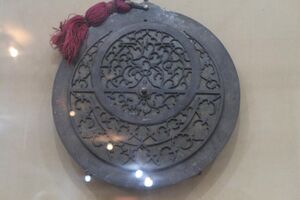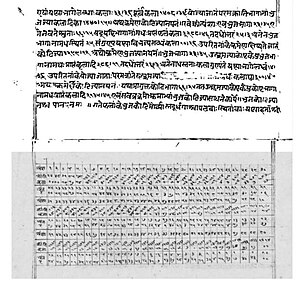Engineering:Yantraraja

Yantrarāja is the Sanskrit name for the ancient astronomical instrument called astrolabe. It is also the title of a Sanskrit treatise on the construction and working of the astrolabe composed by a Jain astronomer Mahendra Sūri in around 1370 CE.[1]
Yantrarāja: The instrument

The ideas leading to the construction of the astrolabe originated in the Hellenistic world. The earliest crude forms of the instrument are believed to have been constructed during second century BCE in Greece. The first person to give a description of the astrolabe was Theon of Alexandria (c.335 - 405 CE). Astrolabes were further developed in the medieval Islamic world where it was widely used as an aid for navigation and as an aid for finding the direction of Mecca. The earliest Arabic treatise on astrolabes was composed sometime around 815 CE.[2]
It is not known when exactly the astrolabe reached India. al-Biruni (973 – after 1050) has claimed in his Indica that he has composed a manual on astrolabes in Sanskrit. Probably he brought the astrolabe with him to Multan and taught its working principles to the Hindu astronomers there. With the establishment of the Delhi Sultanate, many Muslim scholars migrated to Delhi they and might have popularized the instrument among the astronomers there. It was Fīrūz Shah Tughlaq, the third Sultan of the Tughlaq dynasty who ruled over the Delhi Sultanate during 1351 - 1388, who took active interest in promoting the study and use of the astrolabe in India. This was the most important contribution of Fīrūz Shah Tughlaq in the field of astronomy. Mahendra Sūri, the astronomer who wrote the first ever Sanskrit manual on astrolabes was a court astronomer of Fīrūz Shah Tughlaq.
The earliest extant astrolabe constructed in India, now in a private collection in Brussels, is dated 1 February 1601. It was manufactured in Ahmedabad during the rein of Jahangir (1569 – 1627), the fourth Mughal emperor.
Yantrarāja: The manual

With the support and patronage of Firuz Shah Tughlaq, Mahendra Sūri, a Jain astronomer composed the first ever Sanskrit manual on astrolabes. It was Sūri who coined the Sanskrit name "Yantrarāja" ("the king of astronomical instruments") for the astrolabe and he also titled his manual on astrolabes as Yantrarāja. Sūri composed the manual in 1370 CE. Mahendra Sūri's student Malayendu Sūri composed a commentary on Yantrarāja in 1382. Two other commentaries on Yantrarāja are known, one by Gopirāja written in 1540 and other by Yajñeśvara in 1842.
The Yantrarāja manual in 128 verses is divided into five chapters. The first chapter Gaṇitādhyāya discusses the theory behind the astrolabe. The second chapter Yantraghatanādhyāya is devoted to descriptions of the various components of the astrolabe. The third chapter Yantraracanādhyāya describes the details of the construction of the astrolabe. The fourth chapter Yantrasodhanādhyāya discusses method for ascertaining whether the astrolabe has been properly constructed. It is in the fifth and final chapter Yantravicāraṇādhyāya one can see descriptions on how to use the instrument for observational and computational purposes. This chapter also dwells on the different types of astronomical and trigonometrical problems that can be solved using the astrolabe.
While Mahendra Sūri's manual is in 128 verses and contains no data in the form of tables, Malayendu Sūri's commentary is interspersed with neatly prepared tables.
Other Sanskrit works on astrolabe
Over the centuries since the publication of Mahendra Sūri's Yantrarāja in 1370, several other Sanskrit manuals on the astrolabe have been composed. These include the following:[2]
- Yantra-rāja-adhikāra (Chapter 1 of Yantrakiraṇāvalī) by Padmanābha in 1423
- Turya-yantra-prakāśa by Bhūdhara in 1572
- Yantrarāja-vicāra-vimśādhyāyī by Nayanasukhopādhyāya in 1730
- Yantrarāja-racanā by Savāī Jaya Siṃha (1688 - 1743)
- yantrarāja-kalpa by Mathurānātha Śukla (1782)
Additional reading
- For a scanned copy of a manuscript of the treatise Yantrarāja published by S. Dvivedi and Lattara Sarma, Benaras, 1883: Yantraraja (Internet Archive) (Retrieved on 21 December 2023.)
- For a detailed description of an astrolabe constructed in India in 1664 CE and now preserved in Edinburgh Museum: Sreemula Rajeswara Sarma (July 2006). Yantraraja at Edinburgh: On a Sanskrit Astrolabe made for Manirama in ad 1644. Edinburgh: Organising Committee of 13th World Sanskrit Conference. https://archive.org/details/yantrarajaastrolabeinsanskrit/page/n3/mode/2up?view=theater. Retrieved 21 December 2023. (In proceedings of the 13th World Sanskrit Conference, held in Edinburgh, 10–14 July 2006, pages 77 – 110)
- Yukio Ohashi (1997). "Early History of the Astrolabe in India". Indian Journal of History of Science 32 (3): 199–295. https://insa.nic.in/writereaddata/UpLoadedFiles/IJHS/Vol32_3_3_YOhashi.pdf. Retrieved 21 December 2023. This paper includes the full text and English translation of a treatise titled Yantrarāja-adhikāra composed by Padmanābha in 1423 CE.
- Sreeramula Rajeswara Sarma (2008). The Archaic and the Exotic: Studies in the History of Indian Astronomical Instruments. New Delhi: Manohar Publishers and Distributors. ISBN 978-8173045714. Part III of the book containing five articles on astrolabe provides an exhaustive account of the history, construction, distribution and descriptions of the astrolabes in India.
- For a critical assessment of the correctness or otherwise of the statements in Yantrarāja: Kim Plofker (February 2000). "The astrolabe and spherical trigonometry in medieval India". Journal for the History of Astronomy: 37–54. https://ui.adsabs.harvard.edu/link_gateway/2000JHA....31...37P/ADS_PDF. Retrieved 21 December 2023.
References
- ↑ Sreeramula Rajeswara Sarma (1999). "Yantraraja: The Astrolabe in Sanskrit". Indian Journal of History of Science 34 (2): 145–158. https://srsarma.in/pdf/articles/1999_Yantraraja_the_Astrolabe_in_Sanskrit.pdf. Retrieved 21 December 2023.
- ↑ 2.0 2.1 Yukio Ohashi (1997). "Early History of the Astrolabe in India". Indian Journal of History of Science 32 (3): 199–295. https://insa.nic.in/writereaddata/UpLoadedFiles/IJHS/Vol32_3_3_YOhashi.pdf. Retrieved 21 December 2023.
 |

